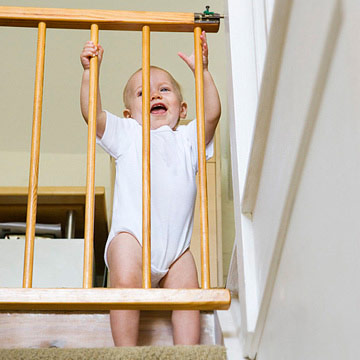
Start early. You'll probably be a little too busy chasing after your crawling/walking baby to tackle babyproofing in your entire house, which is why safety experts suggest that you do it before the baby is even born. This way, you can take your time with each room.
Get on their level. The best way to see all the sharp corners and small objects that can potentially harm your baby is to get down on your hands and knees in each room. Objects that can be broken or sharp if handled need to be placed up high; sharp corners of furniture need to be padded; and items that baby can pull over need to be removed or secured.
Follow the toilet paper rule. Babies love to put anything and everything into their mouth, which means you need to be on the lookout for choking hazards in each room. Any items small enough to fit through the cardboard tube of a toilet paper roll need to be placed out of reach.
Cover outlets. Most are near the floor, so covering electrical outlets is an important step in the babyproofing process. Also be sure to cover long wires and cords that present choking and tripping hazards.
Block baby from… the kitchen, bathroom, and laundry room, where there are a slew of dangerous chemicals Baby can get his little hands on. Think about installing gates to keep your child out of these rooms entirely. At the very least, install latches on every cabinet in these areas.
Mind those steps. Staircases can be awfully attractive to baby, so place a gate at the top and bottom of each staircase in the house. Pressure mounted gates can come loose, so they pose their own danger once baby starts standing (and pulling up on things). Instead, opt for a gate that is mounted into the wall.
Secure furniture. Your bookcases, dresser, china cabinet — all of them are a perfect for a baby to pull up on when she starts to stand and can potentially fall over onto your little one. Be sure to anchor all heavy furniture to the wall.
Watch windows. Roll up blinds cords or use cordless blinds, and put locks on windows on the second floor and higher. Never leave baby in a room attended with an open window. They might be little, but babies can move at the speed of light — especially when you're not looking!
Teach them well. Babyproofing is just half the battle; you also want your child to learn that some activities — touching a hot stove, standing on the couch, etc. — are dangerous and need to be avoided.
Copyright © 2012 Meredith Corporation.
Related Features:




